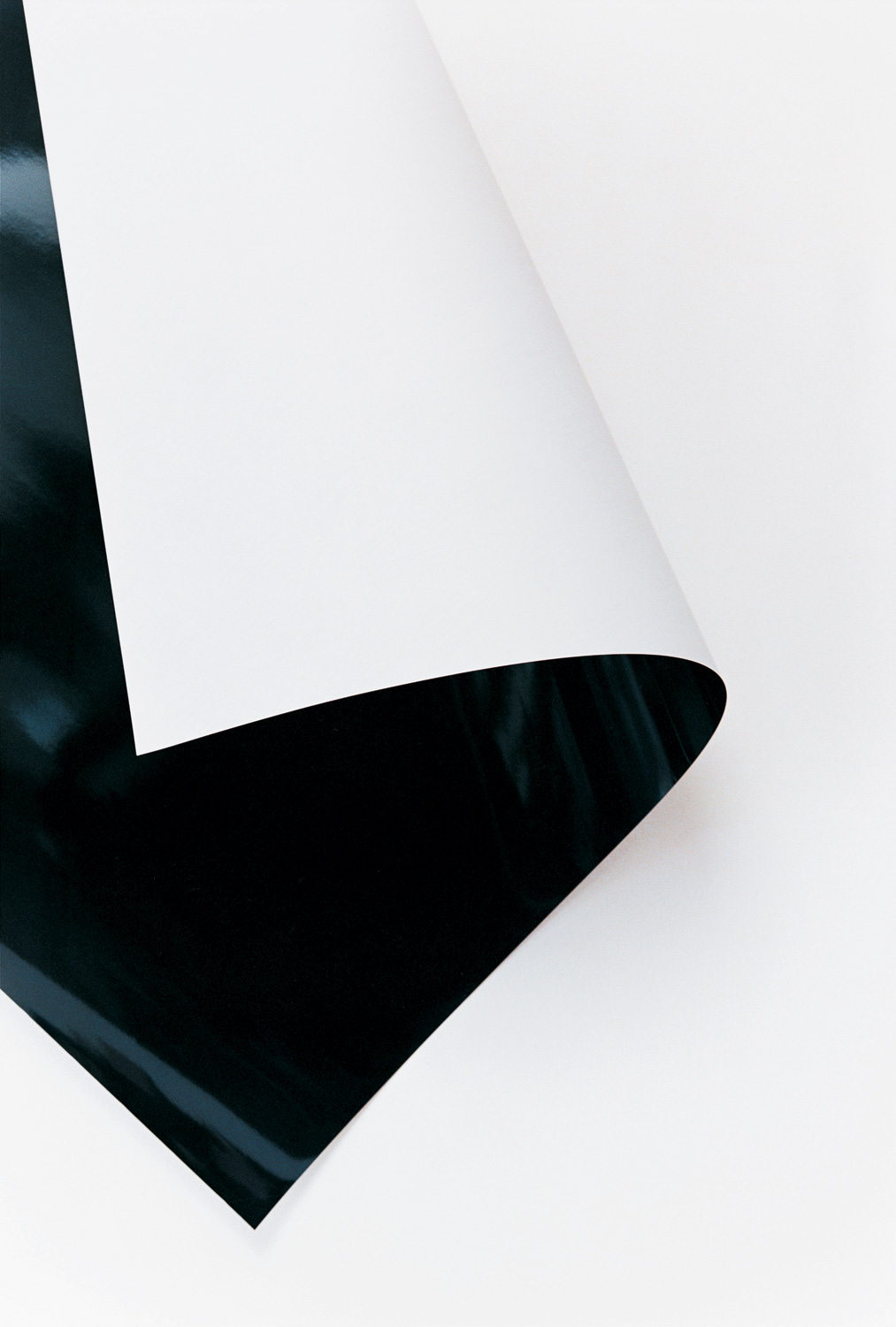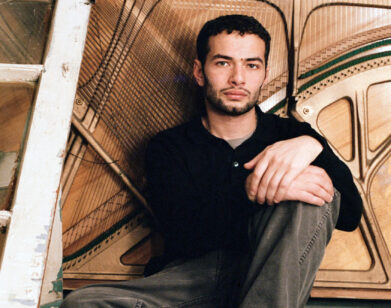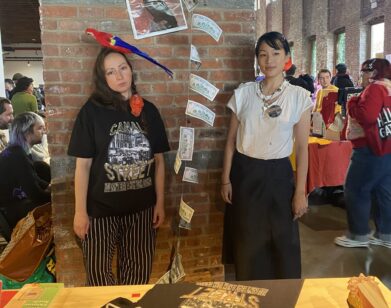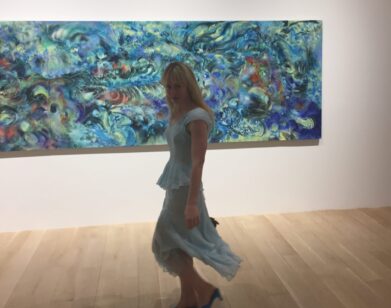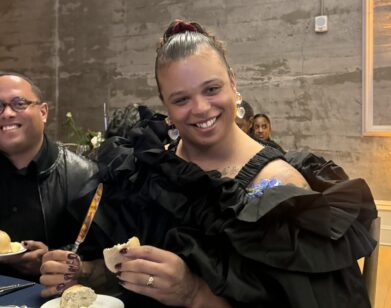Wolfgang Tillmans
Among photographers today, Wolfgang Tillmans occupies a unique position. In the ’80s and ’90s, German photography came to be associated with a sensibility that was cool and measured—with highly conceptual and pictorially minded artists such as Andreas Gursky and Thomas Ruff. Simultaneously, an American style of diaristic photography emerged that was kinetic and emotional—from Nan Goldin all the way to Ryan McGinley.
Over the past 20 years, the Remscheidborn Tillmans has been more peripatetic in his pursuit of ways to constantly reengage his activity with the camera, as well as moving between London, Berlin, New York, and Frankfurt, among other places. His picturemaking addresses his own life, the world around him, his social and political concerns, and it also directly engages the history of the medium. In the mid’90s, he became wellknown for portraits and images of youth culture— whether capturing a radiant Kate Moss or ecstatic bodies on the dance floor—that seemed to effortlessly translate the spirit of the times. They were exhibited in galleries and museums around the world, reproduced in the pages of iD, Purple, and The Face, and brought the artist an immediate international audience. It was as his editor at New York’s index magazine that he and I first worked together in the ’90s, and he shot memorable covers and assignments for the publication, including images of John Waters, Gilbert & George, and Udo Kier.
With the unparalleled explosion of photos in recent years, the now 43yearold Tillmans turned increasingly to abstract pictures produced directly in the darkroom, most often without any camera whatsoever, and his work asked us: What else can a photograph be? If he insists on anything, it’s that there should be new ways of questioning what it is that we see. Nowhere is this more evident than in Abstract Pictures (Hatje Cantz), a new book that brings together more than two decades of his experiments and projects beyond traditional representation. Alternately rigorous, sensuous, beautiful, and beguiling, these pictures further animate a body of work that continues to unfold in unexpected and everchallenging ways. I recently caught up with Tillmans, who was at his studio in Berlin.
BOB NICKAS: You’re in Berlin now?
WOLFGANG TILLMANS: Yes, I’m in the process of setting up shop here, with a huge move of all the contents of my London studio. I had an empty space here for three years as a kind of experimentation ground, and now I’ve switched it around. I’ll keep the London studio as an empty space, and move the center of activity to Berlin.
NICKAS: You were in London for a long time.
TILLMANS: For 21 years—with a couple of years in New York.
NICKAS: I just got your new book, and it’s wonderful. You’re very good with books, but you know that.
TILLMANS: [laughs] Thank you.
NICKAS: It’s a retrospective survey. When we use that term, we’re usually talking about a show, but a book is just as important to you. It has a longer life.
TILLMANS: Books have this function that help me to understand the work I’ve done, to wrap it up. Once it’s done, fortunately, it doesn’t mean there’s closure. Change in my work happens not in revolutions—it’s more evolutionary.
NICKAS: Critics often ask, “What does the photographer bring to the picture? What personal history, what politics, biases, or obsessions?” The abstract photos raise another question entirely, although I think it’s true of all your work. We ask: “What do we, the viewers, bring to the picture?”
TILLMANS: That is a challenge I’ve always taken. I want the pictures to be working in both directions. I accept that they speak about me, and yet at the same time, I want and expect them to function in terms of the viewer and their experience. With these abstract pictures, although the eye recognizes them as photographic rather than painted, the eye also tries to connect them to reality. There’s always this association machine working in the brain, and that is why it is important to me that they are actually photographic and not painted.
NICKAS: I see you as someone who is always thinking in the abstract. Whether it’s a person in front of you or chemicals in a darkroom, you’re looking at color, form, pattern, and visual coincidences. This is important to the way that you put a picture together—whatever the subject of that picture is.
TILLMANS: That’s very true. There is this looking at the world as shapes and patterns and colors that have meaning, and you can’t deny the superficial because the superficial is what meets the eye. The content can never be disconnected from the surface, and this active interest in surface can never be disregarded from the good art that we admire.
NICKAS: It involves a heightened visual sense, looking intimately at what we already recognize. Zooming in, as it were. I’m thinking of how you enlarge a picture and isolate part of it, which you did when you made Xeroxes in the mid’80s—what you call your Approach pictures [19871988], moving closer and closer to your subject.
TILLMANS: Yes, that was really my first work before I even owned a camera. I was enlarging photocopies or photographs in three stages. But in my actual practice, I never zoom. I always have a single focallength lens, which forces me to change position. I see my practice as picturemaking. Whatever is available, I use. In the beginning, it was the photocopier. Then the camera seemed to be the best way to make pictures that talk about what is needed.
NICKAS: I have the sense that you felt from early on, I can do anything. Working with a copy machine stems from punk and ’zine culture, the idea of appropriation, taking images, manipulating them, and reusing them not in the way they were intended.
TILLMANS: I think it’s about an early understanding that values are really relative and are very much to be questioned and can be flipped upside down. Lots of people have that experience and have followed it through the last decades, this constant struggle of youth culture having to defend its validity against accusations of it not being serious.
NICKAS: Against high art.
TILLMANS: But I somehow felt I could embrace both, not even seeing them as contradictory. It’s really only for very narrowminded people to set up this divide. Because how can one start a debate about high and low in 1990 when there are absolutely incredible Kurt Schwitters collages in 1920 that use snippets of newspaper and magazine cutouts?
NICKAS: With the copier, you dealt with images that were already in the world—the way artists use the scan ner today. It’s incredibly direct and very seductive to have an image right away and be able to manipulate it.
TILLMANS: A photocopier is a camera in its own right. I was fortunate to grow up in the time and culture that I did. I was allowed to develop an awareness that the art that really moves me is actually based on an original image. The straight photography that really touched me growing up was printed in magazines and in newspapers. In particular, the early issues of iD, for example, that had their own texture. But I guess it really comes down to this interest in recognizing that any picture can have the potential to move me, to say something, and it can be a canvas by Morris Louis or it can be a picture in a newspaper.
NICKAS: iD was one of the early publishers of your pictures. Once you began to exhibit, people started associating your work with your milieu—the people and sensibilities around you. Your concerns, your private world, and what was happening at the time, entered the public sphere.
TILLMANS: Growing up in the ’80s, questions of style and music and youth culture all seemed inherently political—like gay rights issues, dressing up, wearing makeup, arms protests. A lot of attitude and opinions were expressed through clothes, and they all were meaningful. So in that way, I was so excited about the connection between our private lives and politics—who I kiss, how I like to dance. If you went to a nightclub where you couldn’t wear sneakers, you were rejected at the door. But then in the late ’80s, with acid house, everybody was just wearing sweaty Tshirts and suddenly there was no dress code. But I didn’t aim to publish these pictures simply because they were of my social scene. I truly believed that there was something new happening, that there was a new language in music and a nonhierarchical socializing that seemed radically new. How much that really changed the world, that’s another story. But this coincided with the fall of the Berlin Wall and Europe coming closer together, and nightlife and techno and ecstasy culture seemed like a very powerful panEuropean movement.
NICKAS: When artists find themselves in a cultural moment where there are great changes—and even small changes—they, and photographers especially, can’t help but document that, because it’s your own life and it’s what’s happening around you. Lots of people would say, “Wolfgang is not a documentary photographer.” And yet you are reporting on the world around you, and as these events come into view, you’re part of it. You can’t help but want to participate in a world from which you had been excluded.
TILLMANS: At the same time, when, for example, you now look at pictures from 1968, they are hugely misleading in terms of standing in as an absolute image of the time. Because maybe two percent of the people looked the way that we now associate with that time. I was also aware that what I was aiming for is an idealized, utopian version of how people could be together. I found photography to be a very powerful tool because as long as it looks real, it is perceived as real. That was the foundation for the style that I developed. I made extraordinary things look not particularly staged or extraordinary. Two people sitting naked in a tree is hardly a documentary picture [Lutz and Alex sitting in the trees, 1992], but it was somehow instantly seen as a picture of the zeitgeist, of the reality. That was why I think this whole project worked so well, that some of my pictures were taken on the street and in nightclubs, and others were staged.
NICKAS: It is documentation, because it documents the fantasy.
TILLMANS: Yes.
NICKAS: You once told me that when people look at your photographs they tend to identify a picture that was staged as something you had actually encountered, and conversely, they identify a picture you simply took in passing as the staged situation. The kind of blurring of what you did and what you didn’t do— that’s one achievement of your work. The other thing is that people often purposely stage themselves in the first place. Luckily for photographers, those who dress up want to be photographed.
TILLMANS: But they also appear as themselves, as humans in general.
NICKAS: What attracts you to a person? What happens when, walking in the street, you think, I have to photograph this person.
TILLMANS: I heard this wonderful quote the other day, “Only the brave show what they love.” It’s soembarrassing to approach somebody and say you want to look at them. But without that risktaking, nothing can happen, so I have to make myself vulnerable. What I think is the unifying aspect in people that I like is that they have a sense of their own vulnerability, and I respond to that.
NICKAS: There’s a recent documentary about Candy Darling, and at one point she says something remarkable: “You must always be yourself, no matter what the price. It is the highest form of morality.” This idea of being brave about showing oneself in the world is true for both the photographer and the person being photographed.
TILLMANS: Yes. How people are depicted and how life around me is depicted, and this whole idea of how value is attributed, what is beautiful and what is acceptable . . . these are all questions of style, and style means content.
NICKAS: You’ve spoken about how important it is for you that what’s considered to be beautiful is opened up somehow. Because magazines and movies have a common idea of what it is—a very dominant image that you want to counter in your own way.
TILLMANS: It’s really about representation, and who is represented, and these questions don’t stay the same. They constantly change. Because whatever pictures are put into the world, the balance needs to be readdressed, it needs to be observed. That’s why I am also really questioning what a lot of photography has done since I began. I am not saying because of me, but I mean, photographing some friends partying and publishing the pictures meant something else in ’92 than it does in 2011. And I find the younger generation is not questioning this at all today. Back then, there were almost no pictures available of normal people—how normal people dress and how normal people party . . .
NICKAS: And especially considering who we’re referring to as a “normal person” through the lens of an ad or in a fashion magazine.
TILLMANS: Well, that happened maybe for one season, in ’93. That was also only really a fantasy. Now there is such a closed loop between realness and commercialism that one has to question why do more and more and more of those pictures. It’s almost like everybody deserves a book about themselves, and everybody deserves a whole issue of Vice magazine devoted to them. I don’t know if it’s the right way to put this, but I think it is maybe a good place to say that if I were 20 years younger, I would try and pick up on this, to do something different. I find it soincredibly boring . . . There still is no new photography and no new concerns.
NICKAS: Anything radical or different becomes continually adapted and overtaken, and what was new in ’92 has been in place for a very long time.
TILLMANS: Yes. I mean, one has to ask how many column inches does this Western, innercity lifestyle actually need? Is it really negative to say this?
NICKAS: In Interview magazine? Maybe it’s the best place. Maybe someone will take notice.
TILLMANS: I mean, it’s all about people, and I love people, and photographing people is something I hope I never get tired of.
NICKAS: You’re going back to shooting people after many years of making all these abstract pictures, taking this direction in such a strong way in your work.
TILLMANS: Yes. They happily sit side by side. It’s not that one ends and the other begins. I think if I haven’t done something for a while, there’s also then a need, and not just to continue what I have been doing. I’m 42 now, and it’s dangerous at this stage to be driven by just continuing, by trying to keep it all going. NICKAS: It could have been a real disaster for you at an earlier age, with editors trying to turn you into a celebrity photographer. And you didn’t let that happen. Of course, it makes me wonder if there’s someone famous who you always wanted to photograph.
TILLMANS: For years and years I said that the person I would like most to photograph is Michael Jackson. But that never became a reality. In the year before he died, I actually did reach out, and it never got anywhere.
NICKAS: What about people who were important for you growing up?
TILLMANS: There’s Boy George, who, of course, was my idol as a teenager. I haven’t photographed him, even though I know him now. He wants the pictures to be retouched, and I don’t want that.
NICKAS: Who interests you now?
TILLMANS: Last year I organized a shoot with Lady Gaga, and that worked out. That was just for myself, but this year I did publish a few pictures in iD and in the German music magazine Spex. That was very exciting. She, by her standards, dressed down for me and kept it quite real, which was very nice, and I appreciated it a great deal.
NICKAS: Still, I doubt she wanted you to see her when she woke up firstthing in the morning.
TILLMANS: She’s very pretty without makeup.
NICKAS: Is there one picture that you simply had to do, and really went after?
TILLMANS: The picture of the guy pissing on the chair [man pissing on chair, 1997].
NICKAS: Which was in Honcho [magazine].
TILLMANS:Yes.Ihadtheideaofthisabsurdactofpiss ing on a chair rather than in a toilet or on the ground, and this minimal act being so transgressive, even though no major harm is done.
NICKAS: That chair in that environment represents corporate culture, the business world. It’s really saying, “Piss off” to all that. Plus, the way he looks, with his sort of mohawk hair . . .
TILLMANS: Yes [laughs].
NICKAS: Even without pissing on it, he’s defiant.
TILLMANS: True. I mean, this act, which can be con sidered sexual by some, a pleasurable experience, is at the same time total disrespect. I had once asked a friend to do this picture and he totally refused. So I carried the idea around with me for years. When I was invited to do a Honcho shoot, I approached Phillip, who was the barman at The London Apprentice, and fortunately he knew who I was. He had a copy of my first book, and that broke the ice. At the end of the shoot with him, I realized I could ask him to do this picture. I had waited four years to do it. Sometimes it takes a long time for a picture to incubate. The same with the Concorde photos [of the supersonic airliner in the sky over London, 1996–1997, 2001]. I had been thinking about it for years, but to actually make the commitment and travel out to Heathrow several times a week and aimlessly stare at the sky . . .
NICKAS: These kinds of pictures take you outside of your regular routine.
TILLMANS: Yes, and every time I do that, the rewards are so much bigger than what I would have gotten if I had only done the same as I always do. So each time I make an effort and I get out of a lazy rou tine, it’s amazing how big the reward can be. It’s lis tening to those little ideas knocking on the door in your mind. That’s the important thing, to listen and recognize them. Because big ideas don’t make them selves known as big. They begin with the little, ridic ulous ideas that most people would discard or reject. Every successful picture I’ve done has really been based on taking a very flimsy, fleeting little idea, grab bing hold of it, and taking it seriously.
NICKAS: There’s a thread through all your work, which is a very basic question: “What else can a photograph be?” We see it with the Lighter series [ongoing series, which began in 2005]. The pictures are folded and creased, whether by accident or intentionally—they are about the physicality of a sheet of photographic paper. This goes back to your early decision to simply tape prints to the wall. The photo might be a carrier of great emotion, but it’s still a piece of paper. You insist on that reality.
TILLMANS: And that it has a sculptural presence. This was a surprise when I first showed the Lighter works. Even a taped photograph, which may only be a twentyfourth of an inch thick, always became anobject that extended into space from the wall. And when there was a group of fifty pictures taped to the wall, they had a very spatial presence.
NICKAS: Your installations are so choreographed that walking into the gallery, we feel as if we’ve entered into a giant collage, an activated space. Your photos are pictures of things, but they are also objects.
TILLMANS: They are really color fields—color playing on a purely visual level. That’s why it’s interesting to do these installations where the actual narrative content is taken away and each picture only represents color. The Lighters, in particular, simply refuse to represent. Nor mally every photograph has the duty to represent. They just say, You’re looking at me.
NICKAS: You’ve spoken about the dance floor as a place where we alternately lose ourselves and see our selves in relation to other bodies in space. So there’s a poetics of being transported and attracted. Among the first pictures of yours that I recall was a series titled Chemistry, from ’92, smallformat black-and-white photos taken at Chemistry Club in London. There’s one which is a closeup called armpit. It’s very abstract and, at the same time, very sexy. I hadn’t thought about it for a while, and then I saw an abstract picture in your book that reminded me of it instantly: elbow [2001].
TILLMANS: [laughs] Yes.
NICKAS: Someone should show these pictures together. They offer such a clear example of how, in close proxim ity to a person, whether on the dance floor or in bed— the body allows us to see in the abstract. Artists have done that forever, it’s nothing so new, but you gave a contemporary image to that, and an abstract image.
TILLMANS: Of course, each generation has to give images to that. The mobility of the eye is such a funda mental treasure that we have, and that coexists with sen sation. On the dance floor, you are totally in reality, while also experiencing this dream imagery of changing col ors and wet surfaces of skin. Sometimes it’s the shadow outline in the strobe light, and in another moment it’s the closeup of an armpit that you’re looking into. I’m not photographing all the time, but it’s something that I actually see all the time, and not just on the dance floor. It’s this ongoing coexistence which makes life sensa tional. The eyes have this ability to flip around what they see from one second to another, to see something as an object, and then as a design. That’s really liberating, and I try to convey that in my work, that your eyes are free and you are free to use them. The original interest in mak ing pictures that don’t directly depict came around ’97 or ’98, when I felt there was such an acceleration of images in the world, and that was before Flickr and so on. So I felt a need to slow down how one consumes photographs. With the abstract pictures, I was engaged in trying to find new images, but in practice, it was a bit like throwing a wrench in the spokes. The omnipresence of photogra phy is at a level that it has never been in the history of the world. I feel really curious to now reengage and see what the camera can do for me.
NICKAS: Your show in L.A. at Regen Projects this past spring included a photo of stacks of eggs in a vil lage store in the Philippines, a photo that you took in Times Square of an enormous fashion advertisement, as well as photos you took last year in Haiti. That’s quite a range of images placed side by side.
TILLMANS: Which is a risky position to take. It’s very hard to keep a sense of direction and purpose within chaos and disorder—that’s what I really tried to draw from bringing these pictures together.
NICKAS: Chaos and disorder not only describe the sit uation in Haiti, but Times Square as well.
TILLMANS: Assuming that viewers today have been trained or numbed to an unprecedented degree by this level of image exposure that we see now. I always think that we know so much more than one would have ever known before. But I don’t know if that’s really true.
Bob Nickas is a New York–based critic and curator, and one of the authors of the forthcoming book Defining Contemporary Art: 25 Years in 200 Pivotal Artworks (Phaidon).

